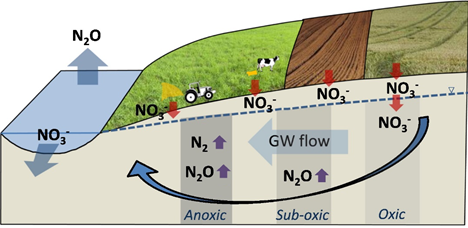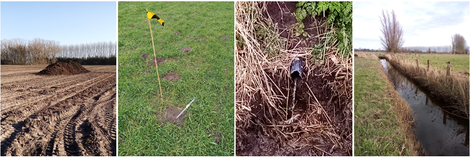Determination of regional attenuation factors for nitrate leaching to groundwater and surface water
Nitrate concentrations in leaching water at field scale differ from measured concentrations at catchment scale in ground and surface water due to dilution and reduction processes. The average ratios between the nitrate concentration just below the root zone on agricultural land and the concentration in ground and surface water are defined as the attenuation factors. These attenuation factors are region-specific and strongly depend on the land use in a catchment and the redox conditions of the groundwater. Knowledge of the regional attenuation factors may facilitate decision-making on fertilization limits and other potential measures to improve the regional water quality.

Two catchments were selected to develop an experimental methodology to determine the attenuation factors for both ground and surface water. In each of these catchments, we are monitoring mineral N in the soil and N uptake on 18 fields with different soil textures and planted with a range of crops and catch crops. Furthermore, we collect management data from the farmers, especially on fertilization. On some fields we also measure nitrate concentrations in soil water and in drain water.
This dataset will enable us to calibrate the EU-rotate_N model, which will then be used to generate catchment-characteristic nitrate residue and nitrate concentration time series averaged over all fields in the catchment, but separated in classes depending on soil texture, N content of crop residues and presence of catch crops. The time series will be generated by simulating N dynamics over a relevant time period based on the age distribution of the groundwater flow in the catchment. These relationships between the nitrate residue and nitrate concentration time series will then be applied per class to ten other catchments, starting from nitrate residues collected by the Flemish Land Agency (VLM) since 2007 and taking regional differences in meteorological conditions and water recharge into account. The generated time series for the nitrate concentration just below the root zone and the time series for the nitrate concentration in ground and surface water (developed by the UGent Laboratory for Applied Geology and Hydrogeology) will then be subjected to a correlation analysis in order to obtain the regional attenuation factors. For surface water seasonal attenuation factors will be determined for both summer and winter. The collected data will also be handed over to the Flemish Environmental Agency (VMM) to serve as a dataset for calibration and validation for the Flemish model NEMO.
This project is funded by the Flemish Land Agency (VLM).
